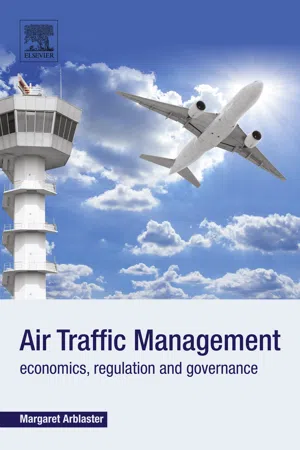
- 286 pages
- English
- ePUB (mobile friendly)
- Available on iOS & Android
About This Book
Air Traffic Management: Economics Regulation and Governance provides the latest insights on approaches and issues surrounding the economic regulation and governance of air traffic management (ATM). The book begins by explaining what ATM is, showing its importance within the aviation industry. It then outlines the unique institutional characteristics that govern ATM, also discussing its implications for economic regulation and investment. Technological developments and the issues and approaches to safety regulation are also covered, as are the implications ATM has on airports. The book concludes with an exploration of future directions, including the entry of drones into airspace and the introduction of competition in ATM services
Air traffic management plays a critical role in air transport, impacting both air safety and the efficiency of air services. Yet air navigation services are shifting from government provision to private industry, creating the need for more critical analysis of governance and economic regulation within the ATM industry.
- Consolidates the latest economic regulation and reform material regarding air traffic management
- Provides numerous practical examples and real-world case studies drawn from around the globe
- Explores economic regulation in both larger and smaller economies
- Written from an objective, informed and practical perspective by an experienced regulation practitioner and researcher
Frequently asked questions
Information
The Air Traffic Management Industry
Abstract
Keywords
Air Traffic Management
What Is Air Traffic Management?

| Service | Description |
|---|---|
| Air traffic management | The dynamic, integrated management of air traffic and airspace (including ATSs, airspace management, and air traffic flow management)—safely, economically, and efficiently—through the provision of facilities and seamless services in collaboration with all parties and involving airborne and ground-based functions (ICAO, Annex 11) |
| Air traffic services (ATSs) | Services that regulate and assist aircraft in real time to ensure their safe operations |
• Air traffic control (ATC) | Service is provided for the purpose of preventing collisions between aircraft and on the maneuvering area between aircraft and obstructions; and expediting and maintaining an orderly flow of air traffic (ICAO, Annex 11) |
• Flight information services | Service provided for the purpose of giving advice and information useful for the safe and efficient conduct of flights (ICAO, Annex 11) |
• Alerting services | A service to warn the relevant bodies when an aircraft in difficulty is in need of assistance from search and rescue bodies, and to give these bodies the necessary cooperation (Baumgartner, 2007) |
• Air traffic advisory service | A service provided within advisory airspace to ensure separation, in so far as practical, between aircraft that are operating on IFR flight plans (ICAO, Annex 11). (The service operates in regions where ATSs are inadequate.) |
| Air traffic flow management | A service established with the objective of contributing to a safe, orderly, and expeditious flow of air traffic by ensuring that ATC capacity is utilized to the maximum extent possible and that the traffic volume is compatible with the capacities declared by the appropriate ATS authority (ICAO, Annex 11) |
| Airspace management | The task of planning and publishing the management of airspace, divided up into air routes, and civil and military control areas reserved for airports, while at the same time guaranteeing the safety and fluidity of traffic (Baumgartner, 2007) |
| Communication, navigation, surveillance | Essential technological systems, procedures, and programs for pilots in the air and air traffic controllers on the ground that facilitate the process of establishing where the aircraft is and when and how it plans to arrive at its destination |
| Communication | The use of communications technologies for airborne and ground-based coordination (passing data and instructions between pilots and controller and between control centers) |
| Navigation | Applications that are used to maximize the capacity of airspace by facilitating flows of traffic between airports and maximizing safe and efficient access to airports (assists pilots to direct their aircraft along safe paths) |
| Surveillance | Infrastructure that is used to enable a safe, efficient, and cost-effective air navigation service (confirming the location of aircraft) |
| Meteorological services | Provision of meteorological information for aviation users necessary for safe and efficient civil aviation operations, including the provision of observations, forecasts, warnings, and advisories |
| Aeronautical information services | A service established within the defined area of coverage responsible for the provision of aeronautical data and aeronautical information necessary for the safety, regularity, and efficiency of air navigation (ICAO, 2016b, Annex 15) |
| Search and rescue services | Assist... |
Table of contents
- Cover image
- Title page
- Table of Contents
- Copyright
- List of Tables, Figures, Boxes
- Foreword
- Preface
- Acknowledgments
- List of Acronyms
- 1. The Air Traffic Management Industry
- Part One. Background on ATM Technical Characteristics, Governance and Safety Regulation
- Part Two. Economic Regulation of ATM
- Part Three. Future Directions
- Index